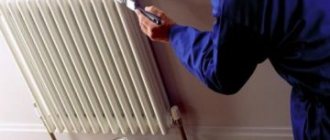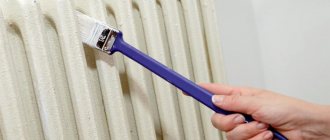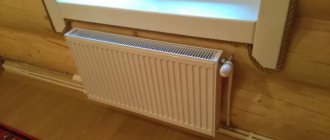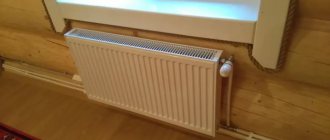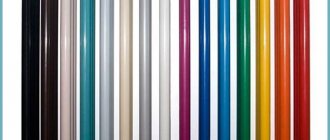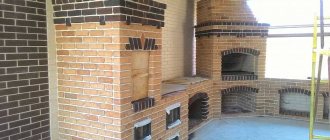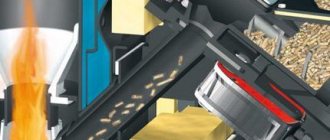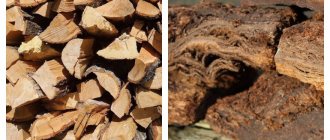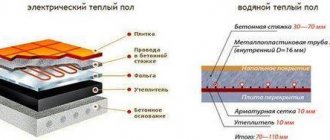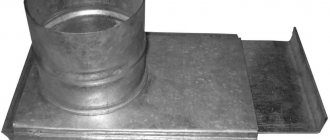Painting heating appliances in an apartment will significantly improve their appearance and provide reliable protection against corrosion. However, the correct choice of paint, surface preparation and application method depend on factors such as:
- metal from which heating devices are made;
- presence and safety of factory paintwork;
- design of radiators;
- cost of paint and solvents;
- availability of manufacturer's warranty.
It should be noted that an excessively thick layer of paint can significantly reduce the heat transfer efficiency of painted batteries.
Features of the painting process
Manufacturers of heating devices consider painting them as a violation of the conditions for maintaining the warranty. Therefore, the presence of damage or peeling of factory paint during the warranty period is a manufacturing defect. In this case, instead of repairing it yourself, it is better to contact the seller to replace the defective batteries.
If the warranty period has already expired, and the surface of the radiators requires updating or restoration, then you should take into account the type of metal from which the devices are made. The fact is that aluminum, steel and bimetallic sectional batteries are painted at the factory with polymer paints, followed by heat treatment.
This coating is highly durable, but has very weak surface adhesion. It is almost impossible to paint such products at home without removing the factory paint, and cleaning the metal surface will require considerable effort.
The recommended option for restoring high-quality coatings on aluminum or bimetallic products is the use of epoxy primer and expensive enamels. However, this processing method requires significant financial costs and certain painting skills.
The easiest painting is for cast iron radiators like M-140 and steel convectors. In most cases, this equipment is only primed at the manufacturer and specially prepared for subsequent painting treatment. It is recommended to apply the paint 2 times to ensure a continuous coating to protect the device from corrosion.
Can batteries be painted?
Self-painting of radiators is perceived by the manufacturer as a violation of the warranty conditions. But what to do if the warranty period has already expired? That's right, paint!
When painting, special attention is paid to the internal elements of certain types of radiators. For example, steel plates of convectors, the so-called comb or “ribs” strung on pipes, cannot be painted. An additional layer of paint will significantly reduce the level of heat transfer. Only the front flaps and screens are painted.
Requirements for paints and varnishes
When deciding which paint is best to choose for radiators, it is necessary to determine the technical characteristics of the materials, which should provide:
- heat resistance of the coating is not lower than 80°C and resistance to color fading;
- resistance to mechanical abrasion;
- high thermal conductivity;
- moisture resistance;
- absence of toxic substances;
- quick drying.
The paint can be glossy or matte. When determining the required gloss of the coating, it is necessary to take into account that even the smallest irregularities and defects are noticeable on a glossy surface.
For cast iron surfaces and complex convector designs, it is recommended to use matte compositions, and shiny paints are well suited for bimetallic and aluminum sections.
Hammer enamel
Hammer paint for painting radiators is a type of alkyd enamel that allows you to create a textured surface and mask defects only with paint. Various pigments can create a hammered texture, the effect of hammer blows and other interesting solutions.
Before painting, the surface is prepared in the usual way - cleaned, sanded, primed, degreased. If the working surface is smooth, it is sanded to obtain small irregularities.
Types of paints used
To paint batteries, one of three types of paints and varnishes is most often used. This:
- acrylic paints for heating radiators;
- oil paints;
- alkyd compositions.
In addition, at home you can find the use of hammer enamels and “silver” made of aluminum powder. In factory production conditions, polymer and epoxy mixtures are used to protect the surface, followed by heat and air treatment.
Acrylic water-based compositions
Odorless paint for heating radiators is made on a binder base of PVA glue or polyacrylates. Since polyvinyl acetate glue is soluble in water, it is not recommended to use the first group of water-based paints for repairing batteries. The coating will have poor resistance to external influences and will require replacement within the first year of operation.
Acrylic enamels are an odorless paint for batteries that forms a thin, strong and durable layer on the surface. Typically the compositions are made white, which can be changed using water-based pigments. The dried layer of paint resembles matte plastic, which is easy to clean with water and does not crack under the influence of temperature.
Oily
Coatings based on drying oils and natural oils are considered traditional and have recently been used everywhere. They form a coating that is quite resistant to negative influences and is affordable for most owners of apartments and private houses. A large number of color shades allows you to solve design issues.
Among the disadvantages of oil paints, experts note:
- coating durability up to 5 years;
- presence of strong unpleasant odors during painting;
- long duration of complete drying;
- increased layer thickness, reducing thermal conductivity;
- drips may form.
When choosing oil paint, you need to pay attention to heat resistance indicators. Not all compositions of this type are designed for operation at elevated temperatures. Incorrect selection of paint can lead to a rapid change in color tone, cracking and peeling of the surface layer.
Enamels based on alkyd resins
In terms of their performance properties, alkyd coatings are superior to oil and acrylic compositions, but only if they are specially designed for painting heating radiators. Therefore, when purchasing, you must carefully study the instructions for use of the materials and only then choose the required shade.
The best heat-resistant alkyd paints are organic and silicone based. The addition of silicon increases the possible operating temperature and for some compositions it can exceed 400°C. They can be used for painting heated surfaces such as heating boilers, chimneys, furnaces, centralized heating pipes with superheated water.
The wide variety of solvents and modifiers used in the production of alkyd paints has provided the market with a large number of these polymer compositions.
When dry, these paints and varnishes release toxic substances. Therefore, when working, it is necessary to ensure the necessary ventilation of the room, and even better, paint outside.
Aluminum powder
“Serebryanka” is one of the most affordable materials. To prepare it, you need to take bitumen varnish BT-577 and add aluminum powder. At the same time, an increase in the amount of powder reduces the mechanical stability of the coating and the maximum operating temperature.
Hammer
The peculiarity of such paints is the original color shade, imitating a heat-treated metal surface and high adhesion, guaranteeing the durability of the coating. The use of these materials eliminates the need for preliminary priming and reduces purchase costs. In terms of their composition, these paints and varnishes are practically no different from the described alkyd paints.
Aerosol packages
Selling paints in aerosol cans can be considered as an alternative to traditional methods of applying paints and varnishes to heating radiators. For their preparation, light solvents are used, which ensure the creation of a thin, quick-drying, even layer. During the painting process, do not bring the can too close to the surface to avoid drips.
How to paint heating radiators with your own hands
Preparing the Battery
Removing the old layer of paint is only the first preparatory stage. In the future, you should adhere to the following recommendations:
- Irregularities and roughness are smoothed out using metal putty. After it has set, the surface of the battery is cleaned again, dusted and degreased.
On a note! If you plan to paint with acrylic enamels, it is better to use acetone as a degreaser, and for alkyd compositions, white spirit or gasoline.
- The next step will be priming. The type of future coating is also taken into account. The basis of the paintwork and primer must be of the same type.
- Each coating (putty and primer) is dried naturally at room temperature.
Painting process
Staining is also carried out at room temperature. In this case, it is advisable to choose the period between heating seasons (before or after). Only some types of paints can be applied to a heated battery.
Painting is carried out in one of the following ways:
- By hand with a brush or roller.
It is better to choose brushes with soft bristles. This way the paint goes on smoother and splatters less. Painting the internal elements of a radiator with a regular brush, as a rule, does not give a good result. To ensure 100% coverage, special brushes are used, curved at a certain angle, with double-sided bristles, etc. (see photo).
- Using a spray gun or an aerosol can.
Compositions sprayed with a spray gun are pre-diluted by 10 percent with water or solvent (depending on the type of paint).
Whatever method you choose, you must adhere to the following rules:
- First, the inside of the radiator is painted.
- To avoid smudges, painting is done from top to bottom.
- It is better to apply the paint in a thin layer. Then it will dry better and not leak.
- Painting is done in 2-3 layers. The next layer is applied only after the previous one has completely dried.
- It is prohibited to paint over the air outlet of an automatic air vent. This blocks it from working.
Coloring video
Recommendations for selection
When determining what paint to paint radiators with, pay attention to the inscriptions and containers printed on the packaging. Conscientious manufacturers will definitely indicate that this composition is intended for painting radiators and heating pipelines, as well as compliance with the State Standard.
The best paints and varnishes are made with the addition of titanium dioxide.
The presence of crushed chalk in the composition can cause a change in color shade as a result of constant temperature heating.
Thicker paints reduce material consumption when painting, while providing a continuous, even coating. Therefore, the mass or specific gravity of the composition is an important technical indicator that should be paid attention to.
Choice depending on radiator material
It is recommended to choose a specific type of paint and processing technology for each metal.
Cast iron
The surface structure of cast iron batteries guarantees excellent adhesion to all types of paintwork materials. Therefore, when choosing a material, you should be guided only by data on heat resistance and external indicators of the coating.
Aluminium, steel and bimetal
Factory painting of such products involves powder coating followed by heat treatment. To improve the adhesion of the surface layer, you can use an epoxy primer or ensure that the section is cleaned as much as possible from the factory coating.
Powder coating.
Nuances of work and useful tips
To ensure that the cladding lays evenly and does not fall off after just a few months, they only work with cold batteries. It seems that the paint will dry faster on hot pipes, but it will lose all its original properties and will soon become unusable.
The direction of painting always goes from top to bottom, so that even if accidental smudges form, they can be slightly corrected.
You cannot paint dusty or non-greased pipes, as the paint will not be able to properly adhere to the base and will quickly peel off.
Painting any surface requires careful preparation, starting with the choice of material and ending with covering other surfaces. The better the base is prepared, the better the result will be.
Average score of ratings is more than 0
Share link
Comments There are no comments yet, but you could be the first...
Famous manufacturers
Among the most common brands offering paints and varnishes for heating radiators are:
- DUFA – Germany;
- TIKKURILA – Sweden;
- Radiator enamel TEX – Russia;
- SNIEZKA – Poland;
- BELINKA – Slovenia;
- LAKRA - Russia.
When choosing paint for several heating devices, it is recommended to buy products from one manufacturer and avoid mixing different varieties. Color changes can be achieved using special dyes added to the paint.
Required amount of paint
Almost every manufacturer of paints and varnishes indicates on the packaging the estimated paint consumption when applied to a flat, prepared surface. Thus, to calculate the required amount, you just need to get the area of the surface to be painted before going to the store, and then correlate it with the information on the label. There is no universal flow rate value.
We recommend taking 10-15% more paint so that there is a reserve in case of unforeseen situations.
The amount of consumables will increase sharply in the absence of soil, dust and contamination. In addition, the use of a sprayer allows you to save paint and varnish compared to using a conventional paint brush.
